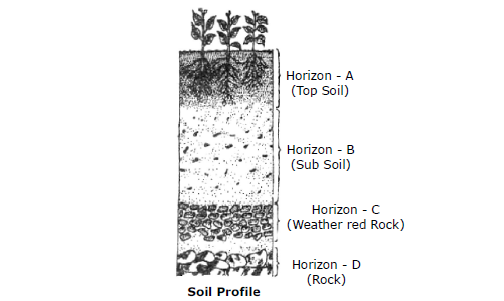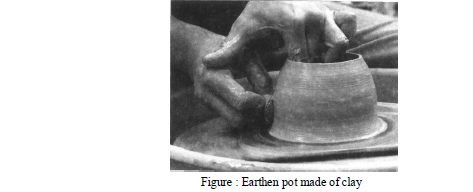Download Class 7 Science Soil Notes Set B in PDF format. All Revision notes for Class 7 Science have been designed as per the latest syllabus and updated chapters given in your textbook for Science in Class 7. Our teachers have designed these concept notes for the benefit of Class 7 students. You should use these chapter wise notes for revision on daily basis. These study notes can also be used for learning each chapter and its important and difficult topics or revision just before your exams to help you get better scores in upcoming examinations, You can also use Printable notes for Class 7 Science for faster revision of difficult topics and get higher rank. After reading these notes also refer to MCQ questions for Class 7 Science given on studiestoday
Revision Notes for Class 7 Science Chapter 9 Soil
Class 7 Science students should refer to the following concepts and notes for Chapter 9 Soil in Class 7. These exam notes for Class 7 Science will be very useful for upcoming class tests and examinations and help you to score good marks
Chapter 9 Soil Notes Class 7 Science
COMPOSITION OF SOIL
Mineral Particles : Soil contains mainly three types of particles : Gravel, sand and clay. These particles determine the texture as well as type of the soil.
Inorganic Substances : Soil contains nitrates, sulphates, phosphates and carbonates of potassium, magnesium, sodium and iron. These salts are derived from the parent rock from which the soil is formed.
Organic substances (Humus) : Organic substances are added to the soil by the activities of plants and animals. Their death and decomposition add organic material to the soil. The completely decomposed product of plants and animals is called humus. It makes the soil fertile and improves its water holding capacity. It also encourages the growth of useful microbes in the soil.
Water : All types of soils generally contain water in the spaces present between the soil particles. Water is needed for plant growth. The type of soil determines its water holding capacity or the amount of water contained in that type of soil.
Air : Air is also present in the soil in the spaces between the soil particles. It is needed for respiration of plants as well as for other living organisms in the soil.
SOIL PROFILE
A side view of the vertical section cut through the soil to the underlying solid through the soil to the underlying solid rocks shows a soil profile (fig.). Most of the soil profiles consist of three layers which are called horizons. These horizons are lettered as A, B and C, the details of which are given below :

A-Horizon :
It is the uppermost layer and is usually the darkest in colour. It contains a lot of humus. Humus makes the soil fertile. Many living microorganisms are also seen in this layer. The soil here is porous, soft and has more water holding capacity than the other layers. The roots of many plants absorb their food from this layer. This layer of soil is also known as the topsoil.
B-Horizon :
It lies under the layer of topsoil and is comparatively harder and more compact. This is also called the subsoil. It is lighter in colour and is often grey or red. It contains more sand and also some stones. Only a few plants or trees have roots long enough to reach the subsoil. Subsoil is not suitable for plant growth as it contains very little organic matter.
C-Horizon :
It is the lowermost part of the soil and lies beneath the subsoil. It is made of stones and rocks. It contains no organic matter. However, minerals are found in this layer. Beneath this layer lies solid rock called bedrock.
SOIL AS NATURAL RESOURCE
Soil is the most important natural resource available to man. It is considered a valuable resource because of the following reasons :
A Base for Growing Crops :
It is the base on which all plants grow. All plants get anchorage, minerals, water and air from the soil.
Storehouse of Minerals :
A large number of minerals are present in the soil. These minerals are extracted and made use of in a large number of industries. Some of the common minerals found in the soil are saltpetre, rocksalt, gypsum, bauxite, haematite and calcite.
Allows Activities that are a source of employment :
Soil is used for various purposes. It is used for the construction of buildings, roads, bridges, industries, dams, etc. It is also used for cultivation of crops. All these activities give employment to thousands of people.
Soil as a Raw Material :
Soil is used as a raw material for making bricks, mortar, pottery and other materials. It is also used in building huts and sheds.
Habitat for Microorganisms :
Soil makes a very good natural habitat for various microorganisms. These microorganisms form humus and make the soil fertile.
Among the animals living in the soil are insects, while ants, grasshoppers, centipedes, millipedes, scorpions, beetles, earthworms and sandworms. Big animals like moles, rats and rabbits build their homes in the soil. Earthworm is popularly known as the farmer’s friend or as nature’s ploughman because of its activities in the soil. It makes burrows into the soil, thus mixing the soil, well, and its excreta called wormcast enriches the soil with nitrogen.
Water storage :
Rainwater percolates through the soil and accumulates above bedrock to form the water table. This water is pumped out by us for domestic or agricultural uses.
SOIL EROSION
Process of carrying away of topsoil by natural forces like water and wind is called soil erosion.
Causes of soil Erosion :
- Large scale cutting of trees (deforestation)
- Overgrazing by animals in forest.
- Improper farming practices.
- Heavy rains or floods.
- Forest fires.
Prevention of soil Erosion :
- Grow more trees on a large scale (afforestation)
- Flood control.
- Allow restricted animal grazing.
- Follow terrace farming.
- Construct bunds.
SOIL POLUTION
The contamination of soil with excess use of fertilizers, insecticides, herbicides, weedicides etc., and dumping of industrial waste, sewage and garbage is called soil pollution. Any substance which lowers the fertility of the soil is a soil pollutant.
Causes of soil pollution :
- Excessive use of chemical fertilisers and pesticides.
- Dumping of garbage and sewage waste in the soil.
- Chemical wastes from industries, mines, and factories, etc.
- Waste materials likes plastics and metals.
Preventing soil Pollution :
- Dispose off sewage properly.
- Recycle waste.
- Use organic manure or vermicompost.
- Treat industrial effluents before discharge.
TYPES OF SOIL
Sandy soil :
This contains more than 60 per cent sand along with some clay. The water holding capacity of sandy soil is very poor. There is a lot of air present in this type of soil. This type of soil is not suited for the growth of plants as it does not retain water of humus in it and is poor in nutrients. Usually, gram, barley, jowar and maize are grown in sandy soils as rained crops.
Clayey Soil :
It consists mostly of clay particles, the sand particles being far less in proportion. Clayey soil is very sticky and so tilling is difficult. It is usually used for making pots and toys.

This soil has very good water holding capacity. It is badly aerated and is easily water logged. However, clayey soil is rich in minerals which make it good for the growth of plants. This type of soil is good of crops like paddy which required a lot of water.
Loamy Soil :
It consists of a good mixture of sand, clay and humus. It has good water holding capacity. It has sufficient aeration. Plants get sufficient mineral salts from this soil. Therefore, loamy soil is the best soil for growing plants. Crops like wheat, barley, mustard, pulses, cotton, fruits and vegetables can be profitably grown in loamy soils.
(i) Alluvial soil: rich in loam and clay.
(ii) Black soil: which has clay.
(iii) Red soil: which is sandy to loam.
(iv) Mountain soil: which is a stony and sandy soil.
(v) Desert soil: which is sandy.
(vi) Laterite soil: which has porous clay.
CBSE Class 7 Science Chapter 9 Soil Notes
We hope you liked the above notes for topic Chapter 9 Soil which has been designed as per the latest syllabus for Class 7 Science released by CBSE. Students of Class 7 should download and practice the above notes for Class 7 Science regularly. All revision notes have been designed for Science by referring to the most important topics which the students should learn to get better marks in examinations. Our team of expert teachers have referred to the NCERT book for Class 7 Science to design the Science Class 7 notes. After reading the notes which have been developed as per the latest books also refer to the NCERT solutions for Class 7 Science provided by our teachers. We have also provided a lot of MCQ questions for Class 7 Science in the notes so that you can learn the concepts and also solve questions relating to the topics. We have also provided a lot of Worksheets for Class 7 Science which you can use to further make yourself stronger in Science.
You can download notes for Class 7 Science Chapter 9 Soil for latest academic session from StudiesToday.com
Yes, the notes issued for Class 7 Science Chapter 9 Soil have been made available here for latest CBSE session
There is no charge for the notes for CBSE Class 7 Science Chapter 9 Soil, you can download everything free of charge
www.studiestoday.com is the best website from which you can download latest notes for Chapter 9 Soil Science Class 7
Come to StudiesToday.com to get best quality topic wise notes for Class 7 Science Chapter 9 Soil

